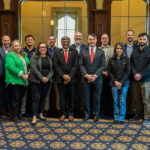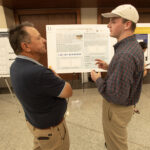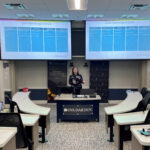Senator Todd Young and NSF Director Sethuraman Panchanathan visit Notre Dame, SpectrumX leadership, to discuss critical investments in science and technology
On Thursday, April 25, Sethuraman Panchanathan, director of U.S. National Science Foundation (NSF), joined U.S. Senator Todd Young in a visit to the campus of the University of Notre Dame. The pair met with faculty, students, and University leaders and discussed how research and innovation can drive better policymaking, grow the local economy, and contribute to national security.
Senator Young explained, “As I travel around the state, I am inspired by the quality of students and the quality of research at our universities—and we have that at Notre Dame. Some of the best research in the country is happening here. That is exactly why I thought it was important that the director of the National Science Foundation come to Indiana, see it for himself, and meet many of the researchers whose projects have been funded by the NSF.”



